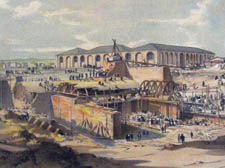|
|
 |
| |

?The chimneys in the top picture, to the right) under construction in 1837 |
Wind-up job for an uphill task
A new heritage trail reveals some ingenious solutions to the challenges of early train travel, writes Martin Shepperd
THE Camden Railway Heritage Trust, which has just celebrated its first anniversary, has set up a Railway Heritage Trail around the many historic sites in Camden.
These include a greatly improved view of the eastern entrance of Primrose Hill Tunnel, the Roundhouse (once an engine shed), the Horse Hospital and the Horse Tunnels which run under the railways. The railway trail will link these and other railway heritage sites by a walk taking about an hour. There are also plans for a visitor centre with maps, photographs, models, exhibits and other visual and acoustic information.
Camden Town has a remarkable place in railway history. It was the operating centre and original terminal of the first railway to connect London with the rest of country. This was the London and Birmingham Railway, built by Robert Stephenson and opened in 1837.
The Primrose Hill Tunnel, 1,164 yards long and with a magnificent eastern portal, was one of the first long railway tunnels in the world. To enter it, the line from Euston to Birmingham turns almost due west to avoid the need to tunnel under Hampstead Hill.
Early engines could certainly not have climbed over the hill. They could not even manage the slope up to Chalk Farm from Euston, to which the line was extended. This problem was made more acute by a decision to go over rather than under the Regent’s Canal, using the spoil from the tunnel to build up the land below the track. This meant there was a fall of 1 in 69 down to Euston.
The problem was met by an extraordinary solution. Underneath the line, just to the south of where it crosses the canal parallel to Gloucester Avenue, Stephenson built a complex of chambers deep underground to house two stationary winding engines with huge pulleys and counterbalancing weights, as well as their boilers and coal.
The engines operated two endless ropes, 7 inches in circumference and 12,240 feet long, which hauled the carriages up from Euston between 1837 and 1844. Equally striking were the two slim chimneys above the engines, standing 133 feet high and making a notable local landmark until their demolition only 10 years later.
Although the original engines are no longer there, having allegedly been sold to Russia, part of this unique relic of Camden Town’s past was briefly seen again recently. Usually flooded, the chambers in which the engines once operated are drained once every six years for inspection, as has just happened. Members of the Camden Railway Heritage Trust accompanied Railtrack inspectors on a tour of the impressive vaults.
|

|
 |
|
 |
|

